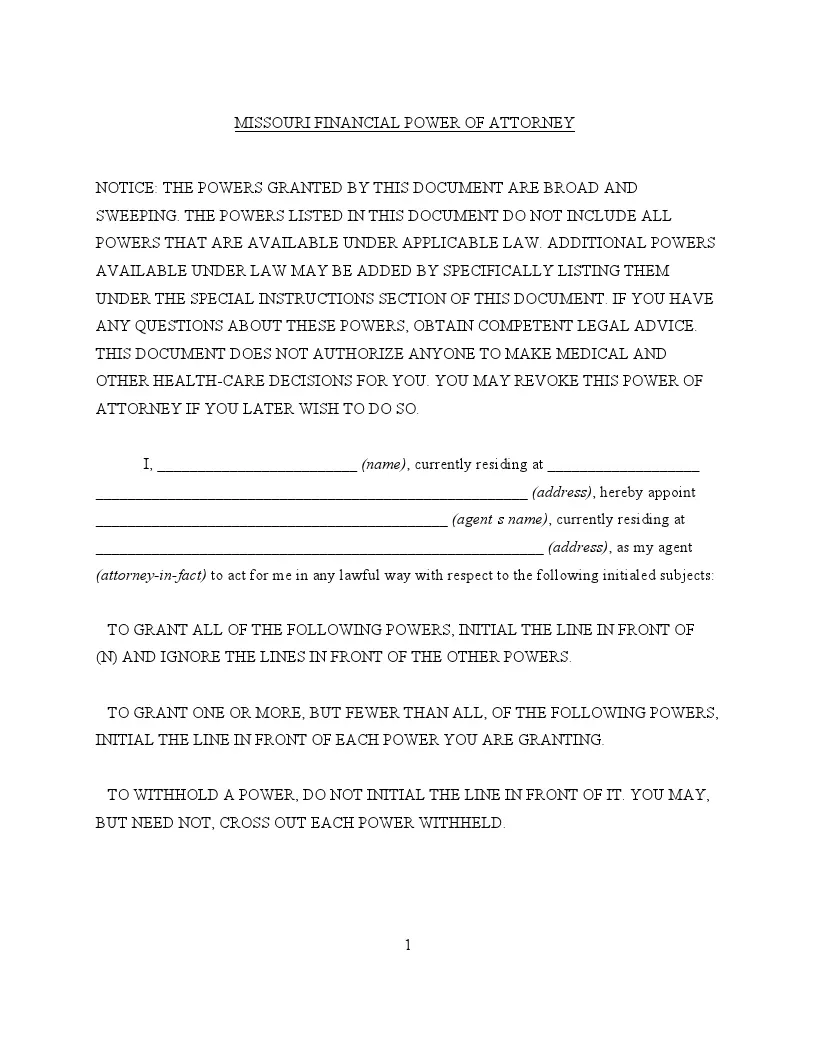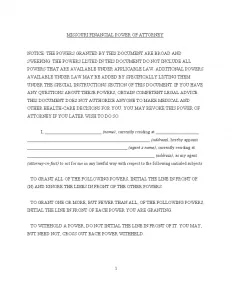Missouri General Financial Power of Attorney Form
The Missouri general financial power of attorney is a legal document that grants one person (the agent or attorney-in-fact) broad authority to handle the financial affairs of another person (the principal). This power includes managing bank accounts, signing checks, buying or selling property, and conducting other financial transactions on behalf of the principal.
The powers granted through a general power of attorney become effective once the document is signed and notarized. These powers continue until the principal revokes them, passes away, or becomes incapacitated, unless the form is specified as “durable.” Use our comprehensive templates and guidelines to get the appropriate Missouri power of attorney documents for any case.

Build Your Document
Answer a few simple questions to make your document in minutes
Save and Print
Save progress and finish on any device, download and print anytime
Sign and Use
Your valid, lawyer-approved document is ready
In Missouri, the laws governing powers of attorney are outlined in the Missouri Revised Statutes. These laws stipulate that a power of attorney, which can be durable or non-durable, is a written authorization allowing an agent to act on the principal’s behalf. The authority granted can be broad, covering various financial and legal decisions. Key aspects of Missouri power of attorney laws include:
- As per Section 404.703, a power of attorney must be in written form, whether durable or not.
- Under Section 404.710, an agent can execute a wide range of actions as specified in the power of attorney document.
It is recommended that the principal’s signature be notarized on a general power of attorney in Missouri. This guarantees the legality of the document and reduces disagreements regarding its authenticity.
Missouri General Power of Attorney Form Details
| Document Name | Missouri General Power of Attorney Form |
| Other Name | Missouri Financial Power of Attorney |
| Relevant Laws | Missouri Revised Statutes, Section 404.710 |
| Avg. Time to Fill Out | 10 minutes |
| # of Fillable Fields | 41 |
| Available Formats | Adobe PDF |
Filling Out Missouri General (Financial) POA Form
Filling out a general power of attorney in Missouri grants significant authority to another person to handle your financial and legal matters. This guide provides a step-by-step approach to accurately completing this form, ensuring it’s legally binding and tailored to your needs.
1. Add Principal and Agent Information
Start by providing your complete legal name and home address in the designated spaces, indicating “I, (name), currently living at (address).” Continue by entering the name and address of the individual you designate as your agent. Accurate information is essential because it determines who is authorized to represent you.
2. Specify Powers Granted
The form lists powers from (A) to (N), each corresponding to different authorities you might grant your agent. You should place your initials next to each power you want to grant. If you wish to empower your agent comprehensively, simply initial next to (N) and disregard the others. To withhold any powers, avoid initialing next to them and consider striking through these items for clarity.
3. Include Special Instructions
Below the powers section is a space for special instructions. Here, you can add specific conditions or limitations to the powers you’re granting. This might include restrictions on handling certain assets or specific conditions under which certain powers can be used.
4. Set the Effective Date
You need to decide when the general power of attorney will become active. If you want it effective immediately after signing and notarization, mark the corresponding option. Alternatively, if you prefer the POA to start on a future date, mark this option and specify the date.
5. Determine the Termination Date
You also need to determine when the POA will end. If you want it to cease upon signing a written revocation, mark this option. For termination on a specific future date, mark accordingly and fill in the date. If the document should end upon your incapacitation, mark this option, noting that medical documentation will be needed to confirm such a condition.
6. Sign and Notarize the Document
Complete the form by signing and printing your name in the designated areas at the end. The document needs to be signed in the presence of a notary public to authenticate your identity and consent to grant the power.
7. Store and Distribute Copies
After notarization, store the original document securely and distribute copies to relevant parties like your agent, financial institutions, and potentially a legal advisor. Ensure your agent has a copy of the general power of attorney and fully understands the responsibilities.
